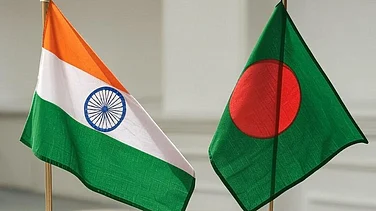As the world entered a new year, the Israeli military confirmed that it would be pulling thousands of troops out of the Gaza Strip. While this does not signal the end to months of relentless attacks on the besieged enclave, it is being seen as a step towards lower-intensity fighting, with Israel’s focus maintained on eliminating militant group Hamas.
Some of Israel’s reservists will be sent back to civilian life as the war since October 7 has also affected Israel’s economy as they have been prevented from going to their jobs, running their businesses or returning to university studies. In an announcement, the army said that five brigades, or several thousand troops, would be taken out of Gaza in the coming weeks. While some will return to bases for further training or rest, the older reservists will go home.
The troop drawdown also came the same day that Israel's Supreme Court struck down Prime Minister Benjamin Netanyahu's contentious judicial overhaul plan that was the trigger behind last year’s protests.
The plan, while not directly linked to the war, is believed to have been the source of deep divisions inside Israel for undermining the country’s democracy, and as a result, threatened the military's readiness before the October 7 Hamas attack that triggered the ongoing war. Politicians had warned against reigniting those divisions and harming national unity.
What does it mean for Gaza?
Israel is now in the third stage of the war—the first was the intense shelling in retaliation to the Hamas attack and the second was the ground offensive that started on October 27—with its tanks and troops having overrun much of the Gaza Strip, despite Palestinian militants fighting from apparent hidden tunnels and bunkers, according to an Israeli official. The withdrawal of some of Israel’s troops, however, must not be confused with a humanitarian pause.
Netanyahu vows to press ahead with its military offensive until Hamas is crushed and the more than 100 hostages still held by the group in Gaza are freed. Moreover, there is no clarity on whether the military plan enables access to medical aid and basic necessities like food, water and electricity for Gazans—something they have been robbed of, apart from a normal life.
The new plan is expected to last for much of the year, starting with the northern region, with a more pointed focus on remaining Hamas strongholds and "pockets of resistance".
Growing tensions in Lebanon
According to the announcement, some of the troops pulled out of Gaza would be sent for rotation to the northern border with Lebanon, where Hezbollah has been exchanging fire with Israel to show solidarity with the Palestinians.
Israel has warned Hezbollah, an ally of the Hamas, to back down or risk a full-on Lebanon war. Both Hamas and Hezbollah are backed by Iran, whose militant allies in Syria, Iraq and Yemen have also been launching longer-range attacks against Israel.
In the cross-border fighting, about 160 people have been killed on the Lebanese side, most of them Hezbollah combatants, three journalists and more than 20 civilians. Meanwhile, on the Israeli side, at least five civilians and nine soldiers have been killed.
What has happened so far:
Israel has come under growing international pressure to scale back its occupation in Gaza which has cost nearly 22,000 Palestinian lives. The United States, one of Israel’s strongest allies, has more than once vetoed the UN vote to call for ceasefire. However, US Secretary of State Antony Blinken has also urged Israel to do more to protect Palestinian civilians. With tensions remaining high across the region, the US announced that it would be sending an aircraft carrier strike group home and replacing it with an amphibious assault ship and accompanying warships. Blinken will be visiting the region next week.
Meanwhile, Israel’s Finance Minister Bezalel Smotrich said that Palestinians should leave Gaza, pushing a narrative reminiscent of the 1948 Arab war, also known as Nakba. He said that what is needed is to “encourage emigration” so as to make way for Israelis who could “make the desert bloom”.
Amid the announcement of troop withdrawal, Israel continued heavy bombardment in the southern region of the Gaza Strip, particularly Khan Younis, which Israel claims to be a Hamas stronghold. At least 21 people were killed and dozens injured; the Magazhi refugee camp and Jabalia's Bir al-Naja area were among the worst-hit zones, with fifteen and six fatalities, respectively, as per local reports.
An Associated Press reporter saw at least 17 bodies, including those of four children, at a hospital in the central town of Deir al-Balah after a missile struck a house. "It is our routine: bombings, massacres and martyrs," Saeed Moustafa, a Palestinian from the Nuseirat camp, told the Associated Press. On Monday, Gaza's Health Ministry said that 156 people had been killed in the past day. At the same time, Israeli military said one of its airstrikes killed Adel Mismah, a regional commander of Hamas' elite Nukhba forces, in Deir al-Balah.
In Israel, Kibbutz Be'eri, one of the communities hit by Hamas on October 7, announced on Monday that Ilan Weiss, who was thought to have been kidnapped, is now believed to be dead. Weiss' daughter Noga Weiss, 18, and wife, Shiri Weiss, 53, were held in captivity in Gaza and released on November 25 during a weeklong ceasefire.
The war has displaced some 85 per cent of Gaza's population, forcing tens of thousands of people in overcrowded shelters or teeming tent camps in Israeli-designated safe areas that the military has nevertheless bombed. Palestinians are left with a sense that nowhere is safe.
Israel has said it is now close to operational control over most of northern Gaza, while fierce fighting continues in other areas of the Palestinian territory, especially the south where most of the 2.3 million civilians fled after Israel’s evacuation orders. The Israeli military claims that many of Hamas' forces remain intact in the south.
The October 7 attack by Hamas on southern Israel was the militant group's fiercest attack against Israel’s years of occupation in Gaza. More than 1,200 civilians and at least 173 were killed, while 240 others were taken hostage by the militants.
Israel responded with an astounding aggression on Gaza, launching an air, ground and sea offensive and killing more than 21,900 people, two-thirds of them women and children, according to the Palestinian health ministry, which does not differentiate between civilians and combatants in its count. This, however, excludes the number of people missing.


























